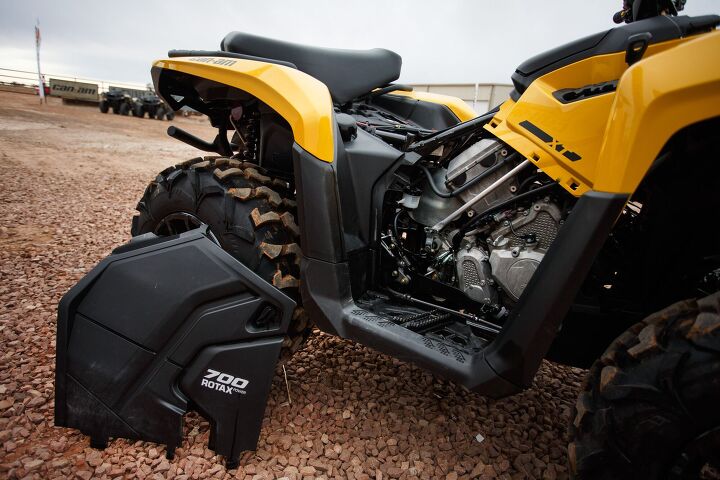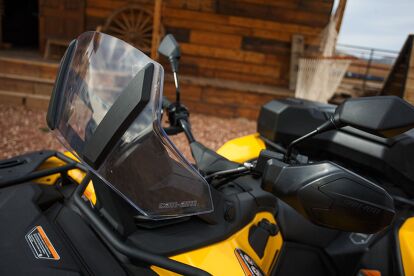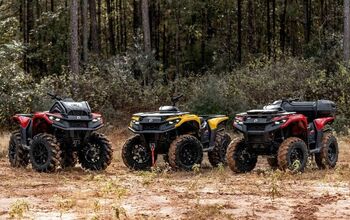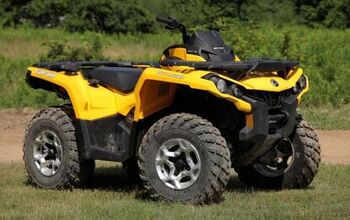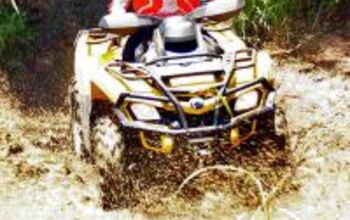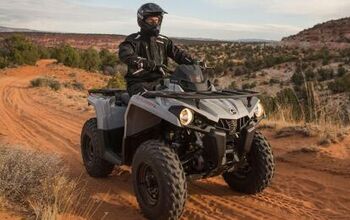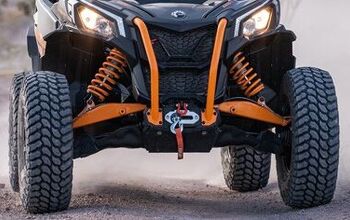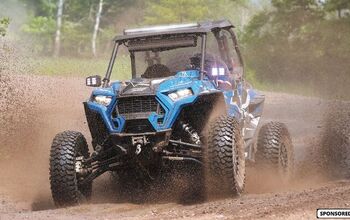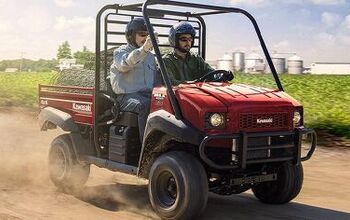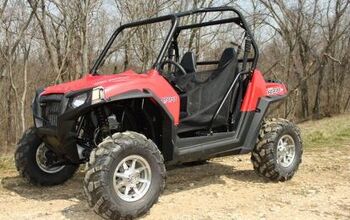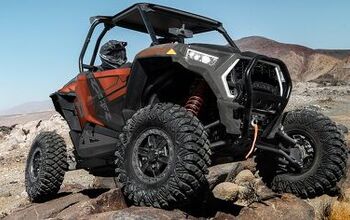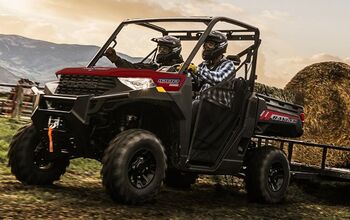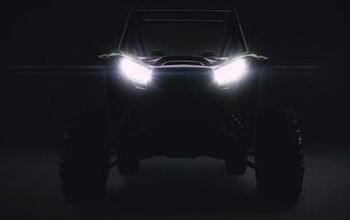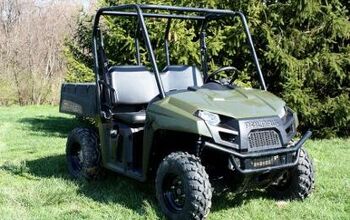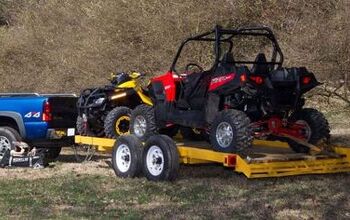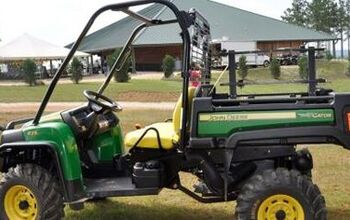2023 Can-Am Outlander 500 & 700 Review

The mid-CC segment is responsible for over half of all ATV sales in a given year, so redesigning the Outlander 450 and 570 was an important job for Can-Am. For 2023, the Canadian-based manufacturer has given us a brand new Outlander from the ground up, packing the new model with smart innovations, useful accessories and changing the model names in the process to the 500 and 700 while also adding the new PRO work-focused lineup.
The all-new Outlander 500 and 700 both use the same powerplant, that being a 650cc single-cylinder engine that makes 40 hp and 37 lb-ft of torque in the Outlander 500 and 50 hp and 41 lb-ft in the 700. Getting the extra grunt to call this engine a 700 requires two changes, ECU tuning and a high-performance camshaft, which means that buyers who stick with the 500 won’t simply be able to flash the ECU for a more powerful tune.
Riding hard on the 700 around a dirt track was our first time experiencing the machine and the power felt strong, offering quick response at your thumb that makes it easy to break the back end loose and rotate your machine at will. It doesn’t match the overwhelming power that the big bore 1000cc models offer to be clear, but it’s more than just adequate if you opt for the larger power output. Go for the 500, and the power feels well matched to the machine and not significantly down compared to the 700.
Power numbers are up a little over the previous model, but the focus of this new engine seems to have been on maintenance and heat dissipation. A new pair of plastic panels pop off the sides of the engine bay once the seat is removed allowing for excellent access to the Outlander’s engine and transmission for easy do-it-yourself oil changes or belt swaps. Heat on the rider’s legs has long been an issue on ATVs, and to combat it, Can-Am has oriented its single-cylinder so that the exhaust comes directly off the backside of the engine and flows direct to the rear of the machine, leaving those panels at your legs feeling cool to the touch after a ride. These two new designs were incorporated thanks to current owner feedback, also the reason that the new shifter linkage is so easy to use. Can-Am admits that the current Outlander shift linkage can easily bind up and require rocking of the machine, so the new Outlander has received a redesigned shifter that works with easy, every time.
More power was also an ask from current owners, and it was achieved thanks to the new engine but also Can-Am’s pDrive continuously variable transmission (CVT), a setup that uses rollers in the primary clutch to reduce friction resulting in smoother power delivery and quicker shifting.
Base Outlander models are offered with only two-wheel drive if that’s all you need, while most four-wheel drive models get the visco-lok QE auto-locking front differential. For those who like to have control, the Visco-4Lok setup is available on select trim packages of the new Outlander such as the mud-focused XMR700, allowing the rider to choose when to lock the front differential thanks to a button on the handlebars.
Dimensions have grown a little with the new 2023 Outlander 500 and 700 coming in at 89.9-inches long, 48.8 wide and 48.2-inches high, resulting in a seat height of 38.6-inches. That is about four inches longer, 0.8 inches wider and about one inch shorter than the outgoing model, interesting when you consider that the seat height on the redesigned machine is four inches taller than the old unit. It didn’t feel significantly taller when riding it and the center of gravity offered a planted feeling, but if you do work with your Outlander and are constantly jumping on and off all day long, four extra inches adds up.
Suspension revisions mean more travel, now sitting at 9.75-inches in the front and 10.25 in the rear, offering excellent bump absorption over rough terrain or even when taken off a modest jump. In the corners, the Outlander 700 XT we rode has a tendency to lean just a little, allowing for easy weight transfer and total control. Predictability is the result of all these changes, allowing the rider to quickly become acquainted with the machine and take it to its limits, all while feeling confident.
Suspension is also the main differentiating factor between PRO and standard models, as the spring rates and dampers are revised to better carry payload. This is the tradeoff of the PRO models, stiffer suspension that will make the ride experience worse, but the work experience better. Luckily the spring rates don’t totally ruin the ride of this model and going for the occasional trail ride will still be plenty fun, but the playful nature of the standard model is lost on the hard suspension of the PRO.
Opting for the PRO also doesn’t bump up the capacity numbers as the rack weight ratings of 120 lbs up front and 240 in the rear are the same for all models, along with a 1,830-lb tow rating. But in the real world, loading this machine up will be more confidently handled on the PRO models, which also get unique bumpers, 6-ply tires, a speed-limiter and standard selectable engine braking.
Tri-mode dynamic power steering (DPS) joins those last two features as a trio of rider selectable settings that all make the machine more useful. The speed-limiter, available only on models that come with the drive-by-wire intelligent throttle control (ITC) system, allows the rider to pick a set speed and then push the throttle wide open while the machine sticks at that speed. Holding your hand in the wide open position is more comfortable than sitting at ¼ throttle for hours on end, so this feature can come in handy on long rides and also if you’re looking to pull certain equipment that needs a set speed for a long period of time like a sprayer. The speed adjustments happen quickly when you jam the buttons, allowing you to even use this setting on a moderately changing trail.
Selectable engine braking is also available here, allowing you to cycle through three settings which can help to hold back big weights if you’re carrying a trailer or if you simply prefer a machine that slows down aggressively when you get off the throttle. Most importantly, allowing the rider to change this setting along with the others make this machine feel customizable to whatever your riding style, or job, is.
The front end of the Outlander gets a new standard storage box that is nestled inside the steel rack, packing a pair of Can-Am’s Linq accessory attachment points which means you can mount a huge range of helpful storage solutions like gas caddies, coolers and more. This is actually the first Outlander that comes with a gas caddy endorsed by Can-Am since the tank sits flush with the top of the ATV’s fenders, leaving it protected. At the rear of the machine the rack also has a shallow plastic tray that allows for accessories to be attached as well, leaving you with a huge range or options for building the Outlander how you want it. A new chainsaw holder is even part of the accessory catalog, showing Can-Am’s willingness to cater to the hard working crowd.
Pricing for the new Outlander begins at $7,999 in Canada and climbs up to $13,999 for the XMR 700. In the US, the base price comes in at $5,999 and tops out at $10,999.
In this mid-cc category you have to build a machine to please everyone, whether you’re working all day in the bush or strictly riding for fun, and that’s exactly what Can-Am has done here. There’s enough model differentiation to keep all riders happy while keeping costs down so you don’t need to spend a fortune for a solid ATV. With the new Outlander, Can-Am is hoping to take a bite out of Polaris and Honda’s market share, and they’ve made all the right moves to make that happen.

More by Stephen Elmer




